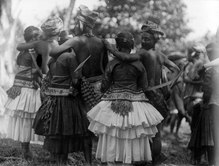
Moraego (or raego, or marego), is the name of a traditional and ritual dance in Central Sulawesi.
In historical time, Central Sulawesi highlanders have performed circle dances and accompanying songs (in Uma raego) at all major precolonial rituals.[1] The Moraego dances and songs were performed to summon and communicate with their pre-Christian deities. They were ritual procedures, among other things, to augment the agriculture and human fertility of highland families. In the course of time many dances have become profane dances.[2]
The first European missionaries and scholars working in the area debated among themselves by the end of the 19th century and beginning of the 20th century if the dances and the songs held a religious component, or were mere secular entertainment. Missionaries, as well as Dutch authorities, sought to reduce the moraego performances for various reasons.[2] For the authorities the problem was that the dances and rituals took time from doing "real work".[2] In the dances there was close physical contact between men and women and this was something European missionaries objected to.[3] Married women did not dance the ´raego, although they and their children were audience to these public events. But the wives participated in the choice and invitation of their husbands dance partners.
- ^ Southeast Asian minorities in the wartime Japanese Empire. Kratoska, Paul H. London: RoutledgeCurzon. 2002. ISBN 070071488X. OCLC 47983728.
{{cite book}}: CS1 maint: others (link) - ^ a b c Kaudern, Walter Alexander (1929). Games and dances in Celebes. The Hague: M. Nijhoff. OCLC 23301224.
- ^ Aragon, Lorraine V. (2000). Fields of the Lord: Animism, Christian Minorities, and State Development in Indonesia. University of Hawaii Press. ISBN 9780824823030.